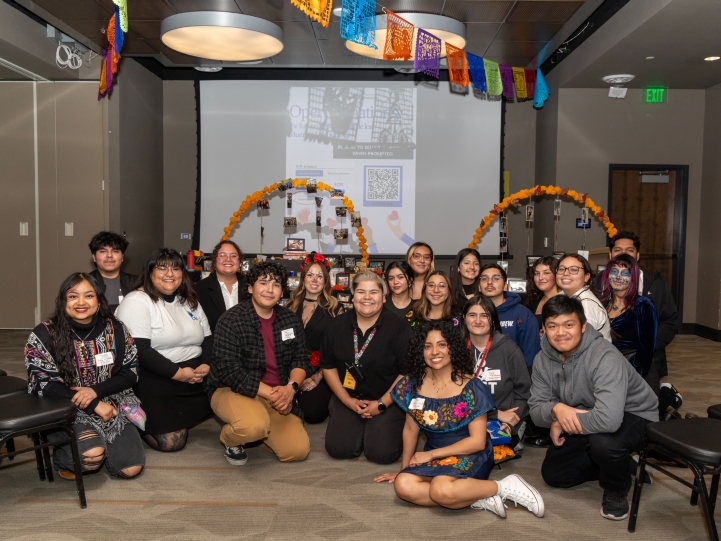Beyond Halloween: How One Campus Embraces Día de los Muertos
Equity, Inclusion and Social Justice Equity, Inclusion, and Social Justice Division Latinx/a/o New Professionals and Graduate Students Graduate New Professional
January 7, 2025
When pumpkin spice lattes start trending, many students begin shopping for Halloween costumes and decorations. However, in some Hispanic households, a different tradition unfolds—Día de los Muertos, where bright colors and sweet treats honor the lives of those who have passed on. This celebration, which originated in present-day Mexico during the time of the Aztecs, continues to be observed throughout Latin America and the United States today. Traditionally celebrated on November 1-2, the holiday invites people to celebrate the lives of departed loved ones while making peace with their transition. A central element of this tradition is an altar, or ofrenda, typically built with multiple layers and adorned with candles, personal artifacts, photos of deceased loved ones, vibrant marigold flowers, colorful skulls, foods, and drinks. For nearly a decade, one Hispanic Serving Institution in Nevada has made this holiday a campus-wide event, celebrating the rich culture of its students.
In 2018, the student leaders of the Nepantla Program—an academic department dedicated to empowering first-generation college students—brought this sacred tradition to Nevada State University after celebrating it off-campus the previous year. Inspired by that experience, they decided to bring their culture to campus and involve the broader campus community in the festivities. Since joining the Nepantla Program professionally in 2021, I have witnessed firsthand the beauty of this holiday being celebrated on campus. While the event has grown each year, its foundation remains unchanged. For one week, our institution's ballrooms are transformed into a space for altars honoring loved ones, groups of people, and social movements. These altars are hosted by various campus departments, student clubs and organizations, and community partners, each beautifully decorated to align with the year's theme.
Each year, our program's student leaders select the theme, drawing inspiration from the curriculum taught during the program's summer bridge. In 2024, our theme focused on honoring our ancestors and the lands we come from. Some memorable altars from this year included the University's Writing Center’s tribute to poets who raised awareness of social justice issues, the Dreamers Club’s memorial to deceased DACA recipients, and the University's TRIO McNair Program’s celebration of Ronald E. McNair’s life.
Last year, on November 1, 2024, we welcomed over 250 campus and community members to an evening of arts and crafts, poetry, storytelling, an art gallery, altar presentations, authentic Mexican food and candy, and a mariachi performance—all centered around honoring those who have passed on. As a first-generation American, this event makes me feel at home, allowing me to celebrate my culture at work alongside students who bring their own experiences and memories to share. It is also the one time a year that I invite my parents and siblings to campus to learn more about what I do as a first-generation professional and meet the students I work with. This night has become a time of cultural celebration and community healing for our Hispanic students while offering all students, faculty, and staff unfamiliar with the holiday an opportunity to learn about its traditions and participate by designing an altar or attending the event. In recent years, we’ve also noticed increased family involvement, with parents volunteering to help with setup or attending the event with their young children.
This event has become a cornerstone of Nevada State University, with student leaders establishing a legacy for future generations to continue. With each incoming cohort of the Nepantla Program, the event evolves further. Inspired by a student this year who grew up celebrating the holiday in Mexico, we added a writing station for “calaveras literarias”, where guests were encouraged to compose short, satirical poems mocking death. Additions such as these make the event special for each attendee, whether they are drawn in by altar-making, arts and crafts, writing, musical performances, or the cuisine.
It is during moments like these that our students shine the brightest—when they are able to bridge their home lives and cultures with their academic lives. This is something that may not come naturally to first-generation college students, but is highly encouraged through events like this. Now consider, in your role, how can you help create spaces and programming on campus that honors the diverse cultures and traditions of your students?

Photo: Nevada State University’s Nepantla Program students, alumni, and staff commemorate the 7th Annual Día de los Muertos Celebration on campus in Henderson, Nevada, 2024.